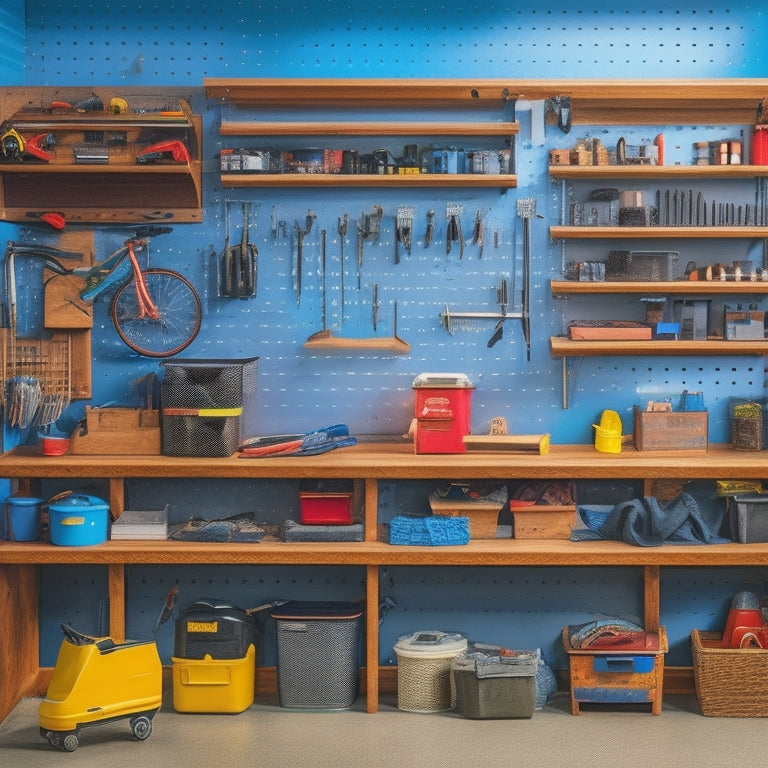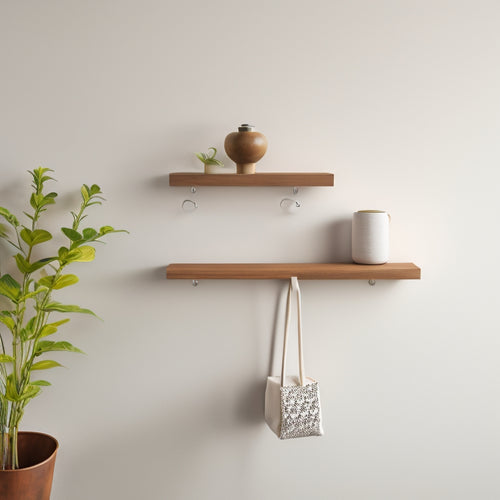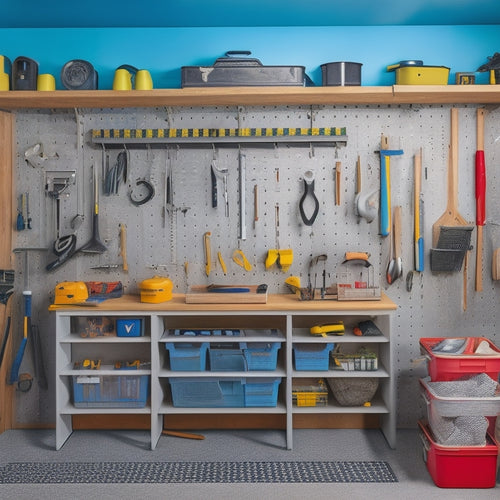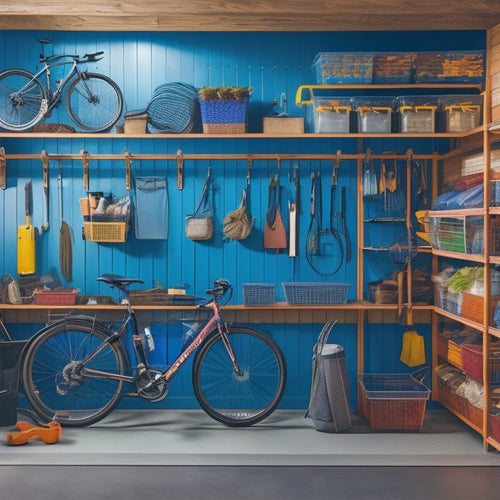
Mastering Garage and Tool Storage for Tradesmen
Share
You're tired of wasting time and money due to a cluttered garage. To master garage and tool storage, start by evaluating your space, taking stock of dimensions, doorways, and existing storage solutions. Categorize your tools and equipment based on workflow needs, and maximize vertical storage with shelves, pegboards, and wall-mounted bins. Design a functional layout that streamlines daily tasks, and implement a maintenance routine to prevent equipment failures. With these strategies, you'll increase productivity and reduce downtime. Now, take the next step towards transforming your garage into a highly organized and efficient workspace that helps you get the job done faster.
Key Takeaways
• Assess garage dimensions, doorways, and existing storage to optimize tool and equipment organization.
• Categorize tools and equipment by workflow needs, frequency of use, and size to reduce downtime and increase productivity.
• Maximize vertical storage capacity with shelves, overhead racks, pegboards, and wall-mounted bins to free up floor space.
• Design a functional layout with zones for specific tasks, easy-to-reach tool locations, and labeled shelving for quick retrieval.
• Establish a regular maintenance routine to inspect tools, clean the garage, and assign designated spots for each tool and equipment.
Assessing Your Garage Space
Take stock of your garage's dimensions, doorways, and any existing storage solutions to identify the space's potential and limitations. This pivotal step will help you determine the best layout for your tools and equipment.
Measure the length, width, and height of your garage, including any obstructions like pillars or windows. Note the location and size of doorways, as these will impact the flow of traffic and access to storage areas.
Next, assess your existing storage solutions, including shelves, cabinets, and bins. Identify what's working and what's not, and think about how you can repurpose or reconfigure these elements to better meet your needs.
Consider the types of supplies you need to store, such as power tools, hand tools, and materials, and think about how you can organize them in a way that makes sense for your workflow.
Categorizing Tools and Equipment
You'll want to group your tools and equipment into categories that make sense for your workflow, such as power tools, hand tools, and materials, to guarantee easy access and efficient storage. This will enable you to find what you need quickly, reducing downtime and increasing productivity. When categorizing your tools, consider the frequency of use, size, and type of project you're working on. For instance, you may have a category for plumbing tools, electrical tools, or carpentry tools.
Tool organization is key to maximizing your garage space. Consider designating specific areas for each category, and use storage solutions like bins, baskets, or hooks to keep items off the floor and out of the way. Label each category and storage solution so you can easily identify where everything is. This will also help you identify what's missing or what needs to be replenished.
Maximizing Vertical Storage
Now that you've categorized your tools and equipment, focus on maximizing your garage's vertical storage capacity to free up floor space and make the most of your available area. This is where shelving solutions and overhead storage come into play. By installing shelves and overhead storage racks, you can store less frequently used items, such as seasonal decorations or infrequently used tools, out of the way but still easily accessible.
To take your vertical storage to the next level, consider the following:
-
Install a pegboard system: This will allow you to hang frequently used tools and accessories, keeping them organized and within reach.
-
Use wall-mounted bins and baskets: These are perfect for storing small parts, nuts, and bolts, keeping them tidy and preventing them from getting lost.
-
Add a slatwall: This will provide additional storage for items like bikes, lawn equipment, and other bulky items, keeping them off the floor and out of the way.
Designing a Functional Layout
By mapping out a functional layout, you can create a workflow that streamlines your daily tasks and maximizes your garage's efficiency. This is achieved by optimizing workflow and creating zones that cater to specific tasks or activities.
For instance, you can designate a zone for tool organization, another for vehicle maintenance, and another for storage. When designing your layout, consider the tools and equipment you use most frequently and position them in easy-to-reach locations.
Utilizing shelving and cabinets can help keep items off the floor, reducing clutter and tripping hazards. Labeling each zone and the contents of your shelving units will save you time searching for specific tools or supplies.
A well-planned layout also allows for efficient movement between zones, reducing walking distances and increasing productivity. By creating a functional layout, you'll be able to complete tasks quickly, efficiently, and safely, ultimately leading to better service for your clients.
Implementing a Maintenance Routine
Implementing a Maintenance Routine
Establishing a regular maintenance routine helps prevent equipment failures, reduces downtime, and keeps your garage running smoothly. As a tradesman, you understand the importance of having well-maintained tools and equipment to get the job done efficiently. By incorporating preventive maintenance into your daily or weekly routine, you can identify potential issues before they become major problems.
Here are three essential tasks to include in your maintenance routine:
-
Tool inventory: Regularly inspect your tools and equipment to make sure they're in good working condition. Make a list of items that need repair or replacement.
-
Cleaning schedule: Set aside time to clean your tools, equipment, and garage. A clean workspace reduces the risk of accidents and promotes organization.
-
Organization tips: Assign a designated spot for each tool and equipment. This helps you quickly find what you need, saving you time and reducing frustration.
Frequently Asked Questions
How Do I Deal With Rust and Corrosion on Metal Tool Storage Components?
You prevent rust and corrosion on metal tool storage components by applying rust-inhibiting coatings, storing them in dry areas, and regularly cleaning and drying them to maintain their metal tool care and protection.
Can I Install a Garage Storage System on a Concrete Floor?
You can definitely install a garage storage system on a concrete floor, but first, guarantee a durable epoxy coating for protection. Plan your organization layout carefully, considering weight distribution and moisture control to prevent damage and establish a sturdy setup.
Are There Any Specific Storage Solutions for Large or Heavy Equipment?
You'll need specialized storage for large or heavy equipment; consider heavy-duty shelving, mobile tool cabinets, or overhead storage with wall-mounted racks to keep your gear organized and easily accessible while saving valuable floor space.
How Can I Prevent Pests and Rodents From Inhabiting My Garage Storage?
You'll want to prevent pests and rodents from inhabiting your garage storage by using rodent repellent and pest control methods, and ensuring a tight seal with sealants and waterproofing techniques to keep them out.
Can I Customize a Garage Storage System to Fit My Specific Trade or Business?
Did you know 70% of businesses struggle with inefficient storage? You can customize a garage storage system to fit your specific trade or business, achieving customized organization and efficiency with trade-specific solutions that offer flexibility to adapt to your unique needs.
Related Posts
-

Wall Mounted Hooks With Shelf for Maximum Storage
You'll find that wall mounted hooks with a shelf are a revolutionary solution for maximizing storage in your home, pr...
-

Advantages of a Pegboard System in Your Garage
You can instantly alter your garage into a more organized, efficient, and productive space by installing a pegboard s...
-

Garage Wall Storage Ideas to Boost Productivity
You can enhance your garage's productivity by capitalizing on your ceiling height with overhead racks, storing bulky ...


